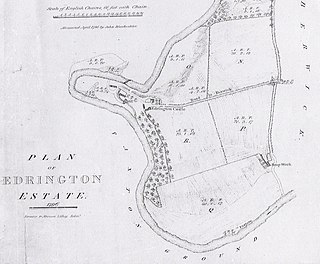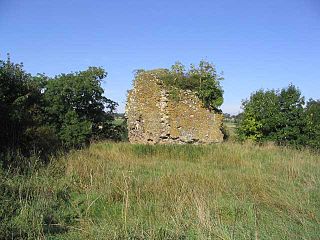Related Research Articles
George Leslie, 4th Earl of Rothes was a Scottish nobleman and diplomat.
John Lauder was Scotland's Public Accuser of Heretics. He was twice sent to Rome by King James V, to confirm the loyalty of the Scottish crown. As Principal Private Secretary to Cardinal David Beaton, Archbishop of St. Andrews, he successfully prosecuted many heretics, who were burnt at the stake, John Knox testifying to his extreme cruelty. Beaton was eventually murdered by the mob, but Lauder escaped and was later Private Secretary to Archbishop Hamilton.
Sir Robert Lauder of the Bass was a Scottish knight, armiger, and Governor of the Castle at Berwick-upon-Tweed. He was also a member of the old Scottish Parliament. The Lauders held the feudal barony of The Bass, East Lothian, Edrington Castle and lands in the parish of Mordington, Berwickshire, Tyninghame in Haddingtonshire, and numerous other estates and properties elsewhere in Scotland.

Edrington is a medieval estate occupying the lower part of Mordington parish in Berwickshire, Scottish Borders, Scotland, five miles (8.0 km) west of Berwick-upon-Tweed. From probably the 14th century, if not earlier, a castle occupied the steep hill above the mill of the same name on the Whiteadder Water. The castle ruin is still marked on today's Ordnance Survey maps, and still appears in locality references in The Berwickshire News. The principal farm of the estate is Edrington Mains.

Sir John Lauder, 1st Baronet, of Newington and Fountainhall was a notable Scottish baillie and Treasurer of the City of Edinburgh, who was raised to a Nova Scotia baronetcy in 1688.

Morham, East Lothian, sometimes spelt Moram, Morum, or Morhame in old records, is the smallest (agricultural) parish in Scotland, sandwiched between five other parishes: Haddington, Garvald, Yester, Whittingehame, and Prestonkirk, in the undulating lower reaches of the Lammermuir Hills.

Garvald is a village south-east of Haddington in East Lothian, Scotland. It lies on the Papana Water south of the B6370, east of Gifford. The combined parish of Garvald and Bara, borders Whittingehame to the East, Morham to the North, Yester to the West, and Lauder to the South. It is mainly an agricultural parish. The red freestone once constantly mined in this parish was well known throughout the whole country.
Sir George Lauder of the Bass, Knight, was a cleric, Privy Counsellor, and Member of the Scottish Parliament. He was a legal tutor to Prince Henry.
Robert Lauder of The Bass was an important noble in Haddingtonshire, the Merse, and Fife. Stodart remarks that "to 1600 the barons of the Bass sat in almost every parliament". He was a firm supporter of Mary, Queen of Scots whom he accompanied to Carberry Hill on 14 June 1567, and fought for at the battle of Langside.
Sir Robert Lauder of Popill was a Scottish landowner and an adherent of Mary, Queen of Scots.
Sir John Home of Renton, Lord Renton was appointed Lord Justice Clerk by King Charles II. He was also a Senator of the College of Justice with the title Lord Renton.
John Sinclair was an Ordinary Lord and later Lord President in the Court of Session. He performed the ceremony marrying Mary, Queen of Scots to Lord Darnley.

Sir Robert de Lawedre (Lauder), Knt., of Quarrelwood, Edrington, and the Bass was Justiciar of Scotia, a Scottish soldier of great prominence and Captain of Urquhart Castle. He is recorded by Fordun, in his Scotichronicon, and in Extracta ex variis Cronicis Scocie as "Robertus de Lavedir 'the good'"

Whitslaid Tower was an ancient Berwickshire seat of the Lauder family for over 300 years. It is today a ruin high above the eastern bank of the Leader Water, 2 miles (3.2 km) south of the burgh of Lauder, in the Scottish Borders. In feudal times it fell within a detached segment of the King's personal Barony of Renfrew.
William Schaw was Master of Works to James VI of Scotland for building castles and palaces, and is claimed to have been an important figure in the development of Freemasonry in Scotland.
Sir Robert de Lawedre (Lauder) of Edrington & The Bass, Knt., was a Burgess of Edinburgh and a confidant of King Robert III and sometime Guardian of his son, the future James I of Scotland.

The Barony of Craigie is a Scottish feudal Crown barony within and near Dundee in Scotland. Craigie has long been incorporated within the boundaries of the Royal Burgh of Dundee; before that it was a barony lying on the periphery of the town.
Sir Archibald Douglas of Kilspindie, also known as Greysteil, was a Scottish nobleman and courtier, who served as Treasurer of Scotland, and was three times Provost of Edinburgh.

Moubray House, 51 and 53 High Street, is one of the oldest buildings on the Royal Mile, and one of the oldest occupied residential buildings in Edinburgh, Scotland. The façade dates from the early 17th century, built on foundations laid c. 1477.
Isobel Hoppar or Hopper was a Scottish landowner and governess of Margaret Douglas. She was a powerful political figure in Scotland during the youth of King James V, and her wealth and influence attracted misogynous comment from her faction's enemies.
References
- ↑ Roll of Edinburgh Burgesses, 1406–1700, Scottish Record Society, p. 298.
- ↑ Registrum Cartorum Domus de Soltre
- ↑ James David Marwick, Extracts from the Burgh Records of Edinburgh, 1528-1571 (Edinburgh, 1875), p. 91.
- ↑ National Records of Scotland]] GD3/2/4/3, an Instrument of Renunciation by George Seton, baker and burgess of Edinburgh, in presence of Lord Seton, of lands of St Germains lying beside the lands of Seton within the constabulary of Haddington, to Mr Henry Lauder king's advocate, and Agnes Stewart (of the Rosyth family) his spouse, because of great injury and wrong done to them in hurting of her at her own place of St Germains, dated 1 April 1544.
- ↑ James Beveridge & Gordon Donaldson, Register of the Privy Seal of Scotland, 1556–1567, vol. 5 (Edinburgh, 1957), p. 308.
- An Historical Account of the Senators of the College of Justice of Scotland from its Institution, by Sir David Dalrymple of Hailes, Bt., Edinburgh, 1849, p. 63.
- The Exchequer Rolls of Scotland , edited by George Powell McNeill, M.A., LL.B., Edinburgh 1895, volume XV, 1523–1529, pps:621, 628, and 648.
- The Exchequer Rolls of Scotland, edited by A.E.J.G.Mackay, M.A., LL.D., volume XIV, 1513–1522, Edinburgh, 1893, page 609.
- Selected Cases from Acta Dominorum Concilii 27 May 1532 – 5 July 1533, edited by Ian H Shearer, Stair Society, Edinburgh, 1951, p66.